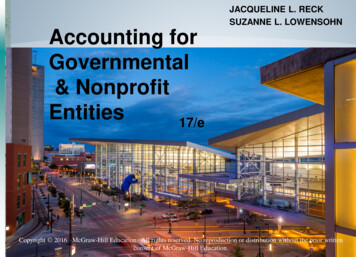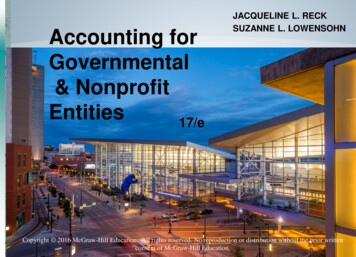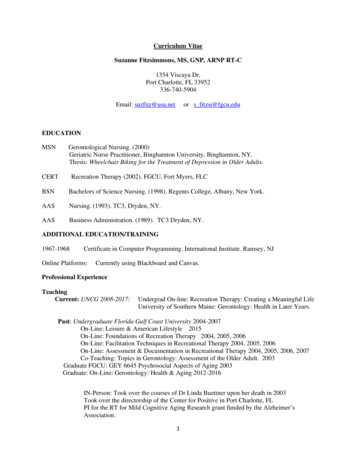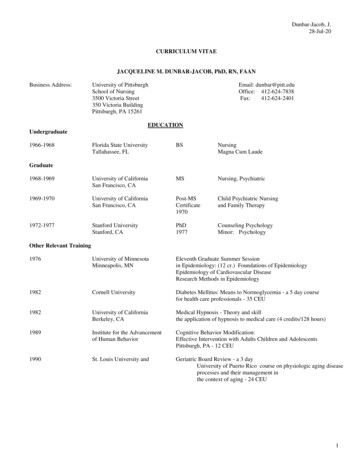
Transcription
JACQUELINE L. RECKSUZANNE L. LOWENSOHNAccounting forGovernmental& NonprofitEntities17/eCopyright 2016 McGraw-Hill Education. All rights reserved. No reproduction or distribution without the prior writtenconsent of McGraw-Hill Education.1-1
Introduction toAccounting andFinancial Reporting forGovernmental andNot-for-Profit EntitiesCHAPTER11-2
Learning Objectives1.Identify and explain the characteristics thatdistinguish governmental and not-for-profit entitiesfrom for-profit entities2.Identify the authoritative bodies responsible forsetting GAAP and financial reporting standardsfor all governmental and not-for-profitorganizations3.Contrast and compare the objectives offinancial reporting for state and local governments,the federal government, and not-for-profitorganizations1-3
Learning Objectives4.Explain the minimum requirements for generalpurpose external financial reporting of state andlocal governments and how they relate tocomprehensive annual financial reports5.Identify and describe the required financialstatements for the federal government, and not-forprofit organizations1-4
Government & Not-for-Profit AccountingPractices Differ from BusinessThey have differentpurposes in societyManagement has aspecial duty to beaccountable forhow resources areused in providingservicesThey are financed byresource providers who donot expect benefitsproportional to theresources they provide1-5
Types of GovernmentsGeneral purposegovernmentsprovide a broadarray of services.Special purposegovernmentsusually provideonly a single orjust a fewservices. Federal government, stategovernments, cities,towns, townships, villages,counties, boroughs, andparishes Independent schoolsystems, public collegesand universities, publichospitals, fire protectiondistricts, and many others1-6
Not-for-Profit OrganizationsNot-for-profit organizations are legally separateorganizations which are usually exempt fromfederal, state, and local taxation.1-7
Characteristics of Government andNot-for-Profit OrganizationsUnlike for-profit organizations, resourceproviders do not expect to receive repaymentor proportional benefits.The organization lacks a profit motive.There is an absence of transferable ownershiprights.1-8
Characteristics of GovernmentOrganizationsPower ultimately rests in the hands of the peoplePeople delegate power to public officials throughthe election processEmpowered by and accountable to a higher levelgovernmentThe organization has the power to tax1-9
Sources of GAAP andFinancial Reporting StandardsFASB Business organizations Nongovernmental not-for-profitsGASB State and local governmentalorganizations Governmental not-for-profitsFASAB Federal government and its agenciesand departments1-10
Objectives of Financial Reporting“Accountability is the cornerstone of all financialreporting in government Accountability requiresgovernments to answer to the citizenry—to justifythe raising of public resources and the purposesfor which they are used.”-GASB Concepts Statement No. 11-11
Objectives of Financial ReportingInterperiod equity is a government’s obligation todisclose whether current-year revenues weresufficient to pay for current-year benefits—or willfuture taxpayers be required to pay for theminstead?1-12
Objectives of Financial Reporting forState and Local GovernmentsGovernmental financial reports areused primarily toCompareactualfinancialresults withlegallyadoptedbudgetAssist inAssessdeterminingAssist incompliancefinancialevaluatingconditionswith financeefficiency andand results of related laws,effectivenessrules andoperationsregulations1-13
Objectives of Financial Reporting forthe Federal GovernmentFederal government financial reportingshould assist report users in evaluatingBudgetaryintegrityAdequacy ofOperatingStewardship systems andperformancecontrols1-14
Objectives of Financial Reporting forNot-for-Profit (NFP) OrganizationsNFP financial reporting should provideinformation useful es andthe ability es,managementobligations,stewardshipnet resources,andperformance and changesin them1-15
Minimum Requirements for GeneralPurpose External Financial ReportingManagement’s discussion and analysisGovernment-widefinancial statementsFund financialstatementsNotes to the financial statementsRequired supplementary information(other than MD&A)1-16
Government Financial StatementsThere are two categories of basic governmentfinancial statements:Government-wide financial statements, whichprovide an aggregated overview of a government’snet position and change in net position andFund financial statements, which provide moredetailed financial information about a government1-17
Government-wide FinancialStatementsAssist in assessing operational accountability—whether government has used its resources efficientlyand effectively in meeting service objectives.Focus on flow of economic resourcesUse the accrual basis of accounting, like businessorganizations1-18
Fund Financial StatementsFor now, think of a fund as a separate set ofaccounts used to keep track of resourcessegregated for a particular purpose – moredetail on funds is in Chapter 21-19
Fund Financial StatementsAssist in assessing fiscal accountability—whetherthe government raised and spent financial resourcesin accordance with budgetary, legal, and regulatoryconstraintsFocus on short-term flow of current financialresourcesUse the modified accrual basis—revenuesrecognized when measurable and available forspending; expenditures recognized when anobligation is incurred that will be paid from currentlyavailable financial resources1-20
Fund Financial StatementsOther fund categories (see Chapter 2): Proprietary funds report on business-likeactivities of the government Fiduciary funds report on fiduciary (trust andagency) activities of the government Both categories follow accounting principlessimilar to businesses1-21
Comprehensive Annual Financial Report(CAFR)A Comprehensive Annual Financial Report(CAFR) provides more detail than the minimumrequirements for general purpose financial reportingWhile not required to prepare a CAFR, mostgovernments do soCAFR is prepared in conformity with GASB standards1-22
Comprehensive Annual Financial Report(CAFR)A CAFR prepared according to GASBstandards should contain three sections.Introductory SectionFinancial SectionStatistical Section1-23
CAFR - Introductory SectionTitle pageContents pageLetter of transmittalOther (as desired by management)1-24
CAFR - Financial SectionThe financial section should contain sufficientinformation to disclose fully and present fairly thefinancial position and results of financial operationsduring the fiscal year. Items included in the financialsection are: Auditor’s reportManagement’s discussion and analysis (MD&A)Basic financial statements (and notes thereto)Required supplementary information (RSI)(other thanMD&A) Combining and individual fund statements and schedules1-25
CAFR - Statistical SectionThe statistical section typically presents tables andcharts showing demographic and economic data,financial trends, fiscal capacity, and operatinginformation of the government in the detail needed byreaders who are more than casually interested in theactivities of the government.1-26
Overview of Federal GovernmentFinancial ReportingFederal financial reporting occurs at twolevels:U.S. government-wide – prepared by U.S. TreasuryMajor agencies and departments – prepared bymajor agencies and departments followingrequirements established in Office of Managementand Budget (OMB) Circular A-1361-27
U.S. Government-wide FinancialReportingDespite the enormous dollar amounts involved, theU.S. Comptroller General has never been able toissue an audit opinion on the federal government’sconsolidated financial statements.In general, serious financial management and datadeficiencies are cited for the Comptroller General’scontinuing disclaimer of opinion.1-28
U.S. Government-wide FinancialReportingThe consolidated report includes:A “plain language” Citizen’s GuideManagement’s Discussion and Analysis (MD&A)Several financial statements (see Chapter 17)Supplemental information reporting on both budgetaryand proprietary (operating) financial activities, as well asreconciliation of the two activities1-29
Federal Agency and DepartmentFinancial ReportingMajor federal agencies and departments mustprepare a performance and accountability report(PAR) that includes an annual performance report(APR), annual financial statements, and a variety ofmanagement reports on internal control and otheraccountability issues.1-30
Federal Agency and DepartmentFinancial ReportingThe PAR should include four sections:1. An MD&A, providing an overview of PAR anda clear description of the department oragency’s mission2. Performance section containing the APR,which provides information about agency’sperformance and progress in achieving itsperformance goals1-31
Federal Agency and DepartmentFinancial Reporting3. Basic financial statements: balance sheet,statement of net cost, statement of changes innet position, statement of budgetary resources,statement of custodial activity and statement ofsocial insurance4. Other accompanying information such asinformation about tax burden, tax gap,challenges facing management, and revenueforgone1-32
Not-for-Profit (NFP) OrganizationsFinancial ReportingThe primary purpose of NFP financial statements is toprovide decision-useful financial information toresource providers, such as donors, members, andcreditors.These resource providers need information to assessthe services provided by an NFP and the ability of theNFP to continue to provide those services, as well asmanagement’s performance and stewardship ofresources.1-33
Not-for-Profit (NFP) OrganizationsFinancial ReportingThose NFP organizations that arenongovernmental in nature are required tofollow FASB accounting and financialreporting standards. These standards requirepresentation of aStatement offinancial position(balance sheet)Statement ofactivities (incomestatement)Statement ofcash flows1-34
Not-for-Profit (NFP) OrganizationsFinancial ReportingIn addition to these statements, voluntary health andwelfare organizations, such as the YMCA, UnitedWay, and the American Diabetes Association, arerequired to present a statement of functionalexpenses.This statement classifies expenses into program andsupporting services categories, in addition totraditional line item classifications.1-35
Reporting Requirements Unique toNot for Profit Organizations Demonstrating accountability for donor-imposedrestrictions by reporting net assets and changesin net assets in the three categories of (1)permanently restricted, (2) temporarily restricted,and (3) unrestricted Reporting program service expenses separatelyfrom supporting service expenses. The latterinclude overhead (such as, non-programmanagement and general expenses) and fundraising expenses1-36
Other Accountability Reporting Popular Reports – highly condensed andunaudited Service Efforts and Accomplishments(SEA) – include both financial andnonfinancial measures of service effortsand service accomplishments1-37
Looking AheadChapters2–9 Discuss in detail GASB principles,standards and financial reporting,focusing on state and localgovernments.Chapters 10,11 and 12 Describe ways that public financialmanagers provide accountabilityover funds entrusted to them.Chapters13 - 17 Focus on not-for-profitorganizations and federalgovernment accounting andreporting.1-38
A Quote from the Original Author“.Even when developed to the ultimatestage of perfection, governmentalaccounting cannot become a guaranty ofgood government. At best, it can neverbe more than a valuable tool forpromotion of sound financialmanagement.”Professor R. M. Mikesell, 19511-39
distinguish governmental and not -for-profit entities from for-profit entities 2. Identify the authoritative bodies responsible for setting GAAP and financial reporting standards for all governmental and not -for-profit organizations 3. Contrast and compare the objectives of financial reporting for state and local governments,











